Today marks 76 years, four months, and twenty-three days.
“I ask him if, as a Palestinian, I can enter these museums and archives? And he responds [that] he doesn’t see what would prevent me. And I don’t see what would prevent me either, except for my identity card.”
Palestinian writer and cultural studies professor Adania Shibli (b.1974) was due to receive an award for her highly-acclaimed 2017 novella, Minor Detail in late October 2023 at the Frankfurt Book Fair. The fair cancelled the award ceremony – the Hamas attacks in Israel on the 7th of October 2023 were cited as the reason.
Minor Detail is no comfort-read. This short two-part novel is based on a true story of a Bedouin Palestinian girl who was kidnapped, gang-raped, then murdered and buried in the sand by Israeli soldiers in 1949, a year after the 1948 Nakba or ‘catastrophe’, which expelled around 800,000 Palestinians from their homes to establish the state of Israel. During the Nakba, Shibli’s grandfather was killed, and her parents were only fifteen years-old.
In the first half of the story, we are thrown into an ostensibly ethnically cleansed Negev desert where a platoon of Israeli soldiers are setting up camp. Shibli zooms in on one particular soldier who we follow minutely as he tries to adapt to the harsh desert conditions, treats a festering infection, and repeatedly patrols the area looking for any remaining traces of life. What the soldiers eventually found did not live much longer after that, and Shibli’s chilling narrative does not shy away from the disturbances that ensued.
Part two jumps to modern-day Ramallah, the Occupied West Bank. Switching, to a first-person narrative, Shibli dives into the thoughts of an unnamed woman researcher who becomes determined to uncover the missing details of the incident after reading the story in a paper and realising it shared the same date as her birthday.
“there was nothing really unusual about the main details, especially when compared with what happens daily in a place dominated by the roar of occupation and ceaseless killing.”
Life Under Occupation
Beyond referring to the woman’s fixation, the book’s title is also literal; in part one, Shibli details practically every movement of the faceless soldier, namely his monotonous washing ritual which Shibli has said is an illustration of “the colonial obsession to clean”. Although this gives the book a slow start, Shibli’s engrossing tale soon becomes difficult to put down.
The woman’s obsession leads her on a dangerous investigation outside of her part of the West Bank – aka ‘Area C’2. Moving from one place to another is not life-threatening for the most of us. However, occupation means that movement for Palestinians is restricted and strictly monitored by the Israeli authorities. We explore this apartheid system alongside the researcher as she takes the risk of sneaking into Jerusalem, which her own identity card doesn’t allow her to enter. She borrows an ID card from a friend, and rents “a car with a yellow number plate, without which one cannot travel to areas beyond Area C.”
The anxiety of the researcher’s every move, calculated to placate suspicion, ails us in turn. Just one minor oversight can put her in danger, one misstep could cost her life.
Shibli also takes the opportunity to share some of her people’s history. Rather than telling us a character’s name, she instead makes us acquainted with the complex geography of the land; checkpoints, destroyed villages, name changes, and the tedious struggle of passing through the infamous West Bank wall.
“most of the Palestinian villages that used to be here have disappeared. I scan the area… searching for any trace of these villages and their houses, which were freely scattered like rocks on the hills... But it’s in vain. None of them can be seen any more.”
The Minor Details That Will Stay Buried
Much like the focus of this story, we will probably never know the truth of all the atrocities inflicted on the people of Gaza and the West Bank these last 12 months, let alone every horror endured by Palestinians since 1948 and beyond.
The confirmed death toll of the Gaza genocide has been frozen at about 40,000 for several months, but is estimated to be 186,000 at least as of July 2024. The ground invasion, destruction of infrastructure, and incessant bombing has led to the displacement of around 1.9 million out of 2.3 million Gazans in what has been described by many Palestinians as a second Nakba.
For years – no, more accurately, forever – the minor details of this past year will gnaw at the gaping holes in our historical records; forced to wonder how many people were killed and in what way – from shrapnel, a sniper, or having eight stories of rubble crush their flesh and bones? And all else that has been lost – homes, birthdays, limbs, weddings, a dignified funeral.
A moment to rest.
After venturing from one Israeli museum to the next, the researcher realises her foolishness. She crosses paths with a woman in her seventies, around the same age as the Bedouin girl would have been had she not been killed. Hoping to hear her lived history, she chases after the woman.
“It was she, not the military museums of the settlements and their archives, who might hold a detail that could help me uncover the incident as experienced by the girl. And finally arrive at the whole truth.”
For offering insight into living under a discriminatory system, providing memoriam for a forgotten victim of colonial violence, and reminding us that history is best preserved through those who live to tell their own stories, Minor Detail gets 4.5/5 stars.
“By the way, I hope I didn’t cause any awkwardness when I mentioned that incident with the soldier, or the checkpoint, of when I reveal that we are living under occupation here.”
Further Reading/ Notes
The West Bank, East Jerusalem, and the Gaza Strip have been under Israeli military occupation since 1967. Gaza has also been under a land, air, and naval blockade since 2007. The blockade has tightened since October 2023, with Israeli authorities preventing humanitarian aid from entering the Strip.
Since the 1995 Oslo II accords, the West Bank has been split into three areas: Area A is administered by the Palestinian Authority (PA); Area B is under the PA and shares security control with Israel; and Area C – which covers 60% of the West Bank – is under complete Israeli administration. More can be read here.
Road map of the state of Israel and occupied Palestine showing the segregated road system. Credits to Visualising Palestine.





